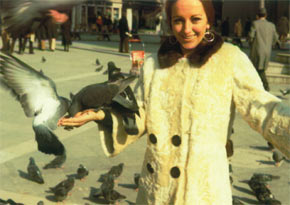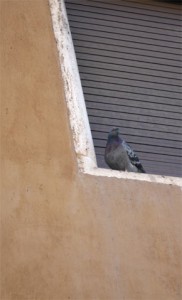What do Xerxes, Julius Caesar, Genghis Khan, Napoleon Bonaparte and General Pershing have in common? They all dispatched field maneuver orders, battle results or other vital messages by carrier pigeons. No human could outrun sunlight, arrows, spears, or bullets, but the lowly bird could carry messages to home destinations by soaring high above fields, valleys, mountains or seas.
As far back as 3,000 years ago Egyptians, Persians, Etruscans and Greeks sent messages by carrier pigeons, and secured the precious birds in purpose-built dovecotes with as many as 2,000 pigeonholes. Romans built coops, called columbariums, throughout the empire and introduced pigeon culture to the Mediterranean and Britain. Fortresses housed the working birds in lofts above observation towers to protect the couriers from predators or theft, and in medieval times, pigeon sanctuaries were only owned by privileged classes in castles or chateaux.

At the height of the Industrial Revolution when the first telegraph lines were connected in 1860, Paul Reuter ironically employed a fleet of 45 pigeons to deliver closing stock prices for the new communication technology, and the banking Rothchilds used birds to send market results. Recently in Orissa, India, the internet put fleets of postal bird carriers out of business, and the Afghani Taliban has forbidden all bird ownership to prevent pigeon-grams.
Pigeons are not always a good thing; overpopulations in metropolitan cities cause extensive damage, such as the culprits in Venice, estimated at 130,000, targeted for vector control because they cost the city over a million euros a year. The once-quaint habit of tourists feeding the pushy pigeons that literally carpet St Mark’s Square for all-day bird banquets is now outlawed, and licensed birdseed vendors have been put out of business. The pesky birds perch in cornices and apertures of Venice’s delicate historic buildings and churches, and claw and peck at calcium-rich marble facades. The attractive nuisance of the iconic pigeons soaring over St Mark’s Basilica may soon be a thing of the past.
Homeward Bound
Pigeon research shows their efficiency; they can fly at speeds of 75 mph, but average 50 mph on 600-mile trips. The birds, of the Columba genus, set goal directions with a natural ‘compass’ enabling them to determine relative flight routes by detecting the earth’s magnetic field and spatial odor distribution. Flying by olfactory navigation, they are oriented to their home lofts by instinct, visual landmarks, roads, buildings and other man-made features.
Messenger homing birds have worked for room and board for millennia, but few pigeons have actually been awarded with medals for heroism, as those which flew in the Great War, and then again when they were called into service in World War II.
During World War I, when battles were fought on many fronts in unforgiving foxholes, muddy trenches and the fields of Flanders, lowly pigeon carriers had daunting tasks of flying messages through poison gasses and flying shrapnel. At the brutal battle of Verdun, thousands of pigeon batches relayed messages, but one heroic bird named “Che Ami” entered into legend by saving the lives of 200 Americans on October 4th 1918. German gunfire had already killed over 300 soldiers, trapped behind enemy lines, and the remaining 200 were being bombarded by their own friendly fire. Twelve courier birds had already been shot down and “Che Ami” was the only one left. An officer attached a canister to the bird’s leg with a message, “We are along the road parallel 276.4, and our own artillery is dropping a barrage on us. For heaven’s sake stop it!” Even though the bird was shot, it returned to the loft; 25 miles in 25 minutes.
When the pigeoneer soldier retrieved the message in the coop, “Che Ami” was on his back bleeding; he had a hole in his chest, his leg was blown off and an eye shot out, but he had saved 200 men of the 77th Infantry Division. His handler made him a wooden leg and the hero pigeon received the French Croix de Guerre medal for heroism. “Che Ami” was decommissioned, sent home on a troopship, and met by General Pershing in New York. The bird died on June 13th 1919, and his frail body was preserved. The hero bird of the Great War remains a legend, displayed with its Croix de Guerre medal, standing forever proud, mounted on a wooden leg in the Smithsonian Museum of American History.
When the United States entered World War II, they ‘drafted’ pigeons into service for intelligence communiques; the British were already using the valiant vector courier program. The Germans too had couriers, controlling entire homing pigeon racing unions, and even trained falcon interceptors to take down the British messengers. Predator programs on both sides proved problematic; falcons, unable to discern the German couriers from British ones, intercepted anything that flew.
When the British First Airborne Division Signals parachuted into Holland, pigeons were carried in chest-attached baskets or air-dropped as intelligence vectors. The Confidential Pigeon Service was used by the Dutch and French resistance by attaching vital messages to birds to carry 240 miles across the English Channel. When intelligence could not be radio-transmitted, due to interception or inability to thread wires over rough terrain, combatants fitted pigeons with aerial micro-cameras to capture enemy positions, and during the Invasion of Normandy, the birds were invaluable to allied operations by carrying dispatches to the allied beach raiders. During a fierce battle at Monte Cassino in Italy when British troops were stranded behind German lines, they used their last three courier pigeons that arrived with SOS dispatches minutes before B52 bombers were taking off to bomb the area.
Pigeons also worked as lifesavers in naval and Coast Guard search and rescue operations, and were standard passengers aboard ships, planes and bombers, trained to carry messages about downed planes or ships lost at sea. As pigeons can differentiate colors, on rescue missions, they alerted searchers to survivors wearing red or yellow, bobbing in the waves.
With courier successes, the US Government conducted a national census of racing pigeons, and when the Signal Corps issued a call for both genders at $5 each, they secured hundreds of thousands of birds. The American Racing Pigeon Union patriotically offered their most prized birds for the war effort; their 600-mile fast-flyers, and G.I. pigeoneers cross-bred the fastest birds with the best homing instincts, putting the sturdy inductees through rigorous training. They moved field mobile lofts daily for three weeks for birds to memorize aerial bearings of their combat coops.
When couriers were ready for combat missions, it was discovered that males were driven by hunger, jealousy and sex. If a male saw its mate with another male at the onset, the fear of a ‘Jody’ bird scenario would make it fly home faster; a staggering 96 percent reaching their destinations.
Thirty four of our animal kingdom fine feathered-friends proved courage beyond the call of avian duty, and for distinguished service they received the coveted Dicken Award. Many stories tell of MIA or POW couriers or of incredible bravery under fire—like dark-feathered “Blackie Harrington” who served at Guadalcanal, and though badly wounded completed his Pacific missions. “Blackie” was rewarded a cushy retirement; servicing in a breeding loft, as was blue-checked “G.I. Joe” who flew for the 56th Infantry, and gallantly saved a thousand men from a bombing raid in 1943.
Many pigeons have been honored by the countries they served, the men they saved, and how their unique flight service affected battles. Though bird fanciers have paid as much as $132,000 for a single stud pigeon; the storied war birds were priceless as life-savers. The beloved little heroes of the feathered animal kingdom deservedly ‘won their wings’ and the birds of the air have justly earned a revered place in wartime history.
Racers of Alamo
While researching, I serendipitously found a local pigeon-racing enthusiast, John Bellandi, owner of Alamo Feed & Grain, noted for its life-size horse on the roof. I spoke with Charles Petrovich and learned that racers are homers, but homers are not necessarily racers. Racing pigeons are prized for speed and pedigreed bloodlines. “The Red Hen,” originating from the Belgian Janssen brothers, was imported in 1963 by breeder extraordinaire, Hank Vernazza. “Red Hen” was an upper echelon class of royal bird blood and the source of Vernazza’s fame among multi-club combines. Birds are registered through combines to compete in Young Bird or Old Bird Races; trucked in and tossed from places like Idaho or Nevada to fly home, the winning times clocked at arrival on the board.
Charles explained, “Birds don’t fly over mountains, they fly road routes, following my truck and then take off. When I arrive at my Antioch loft, they’re waiting for me. We have overfly handicaps — the difference could be 100 miles between lofts.” I asked about homers and racers. “Our birds are bred and trained for speed. We call the wild pigeons ‘barnies’.” I knew about barnies — they nested at my house.
To get the coop scoop, I checked into an online chat room. One pigeon fancier posted that the fastest bird ever was probably “True Grit,” found as an egg in a coop, incubated by a hen and whose bloodline was of unknown parentage. Others of legendary status are “Super Crack,” “Dreamboy,” and “Eurostar.” I followed chit-chat that the Belgian Janssen breeders had the best pedigreed bloodstock, still dominating in high-end auctions.
Pigeon racing is still a viable big-stakes sport with 15,000 registered lofts, and Queen Elizabeth’s high ranking loft won first place in 1990. In South Africa, the Sun City Million Dollar Race pits over 4,000 international birds all vying for a $1 million purse. Pigeon squabs are airlifted, trained and acclimatized in the grueling African veldt before the big race. Even also-rans win big purses and expensive cars—in short there are no birdbrained contestants in this sport — it for is for winners who fly fast and soar high.

Leave a Reply